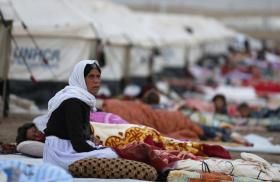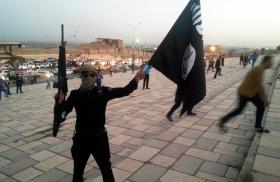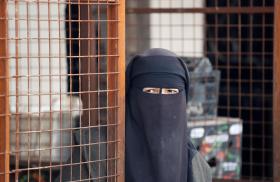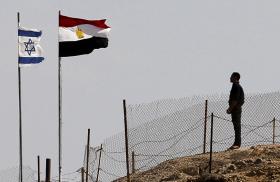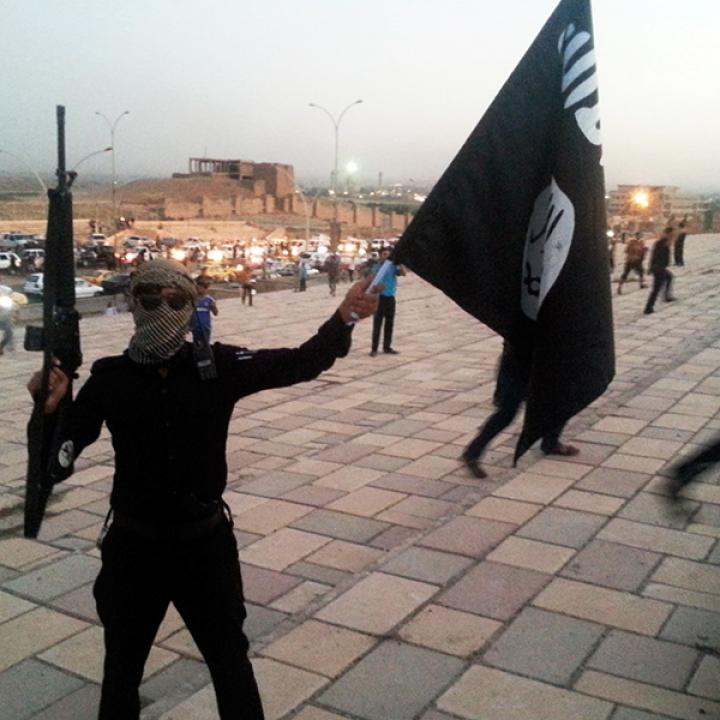
- Policy Analysis
- Counterterrorism Lecture
The Islamic State Five Years Later: Persistent Threats, U.S. Options

Part of a series: Counterterrorism Lecture Series
or see Part 1: U.S. Efforts against Terrorism Financing: A View from the Private Sector
A U.S. counterterrorism envoy reviews the progress made after five years of fighting the group and explains Washington’s thinking on where the global coalition goes from here.
On March 21, The Washington Institute hosted the latest event in its Counterterrorism Lecture Series, featuring State Department official Ian McCary. The following is his statement for the record.
Thank you to Aaron and the Washington Institute team for hosting me today. As Aaron mentioned, I sit in the State Department’s Counterterrorism Bureau, currently serving as the Deputy Special Envoy to the Global Coalition to Defeat ISIS.
On March 23, 2019, almost exactly five years ago, the coalition and its local partners liberated the final stretch of territory controlled by ISIS in Baghuz, Syria. This was and remains a milestone in our continued efforts to ensure ISIS cannot resurge. We are here today to mark the five-year anniversary of this moment—the territorial defeat of ISIS—an accomplishment that continues to protect the United States and our allies and partners, and which has improved the lives of millions in the region.
As we commemorate the fifth anniversary of the territorial defeat of ISIS and also approach the coalition’s upcoming tenth anniversary, I would like to reflect today on four factors: first, how the United States led the formation of the Coalition to Defeat ISIS; second, our progress over the past five years since the liberation of Baghuz; third, the evolving nature of the ISIS threat; and fourth, I’d like to preview some of our thinking on where the coalition goes from here.
Above all, I would emphasize that as leaders of the D-ISIS Coalition, we are clear-eyed about the continuing threat ISIS still poses and remain highly engaged in this endeavor. I am constantly impressed by the commitment and determination of our allies and partners to achieve the group’s enduring defeat even as competing issues increasingly crowd the international agenda.
We continue to see a real threat in Iraq and Syria, where ISIS at one point controlled a region with a population of approximately ten million people. And we have seen the emergence of ISIS affiliates—the so-called ISIS-Khorasan inside Afghanistan, which poses a clear external threat—and in sub-Saharan Africa, where several ISIS affiliates have emerged.
I will come back to the current state of the fight a little later, but let’s reflect for a few minutes on the past ten years. The Global Coalition to Defeat ISIS was formed in September 2014 with twelve original members; by December 2014, it had grown to sixty members. Today, the coalition includes eighty-seven members, bringing together countries from every continent. Through coalition action, we achieved the territorial defeat of ISIS in Iraq and Syria. We have eliminated or captured ISIS leadership on several occasions. We have significantly reduced the organization’s ability to carry out attacks in Iraq, Syria, and elsewhere. And through the coalition, the international community has invested billions of dollars in stabilizing and helping revive liberated areas. This progress is a testament to the strength of the coalition and the courage of our partners on the ground.
2014 saw the precipitous fall of Mosul and the seizure of territory stretching from northwest Syria to the outskirts of Baghdad. To push back, the international community came together to form our global coalition and created the Combined Joint Task Force-Operation Inherent Resolve (CJTF-OIR) under coalition auspices. From its inception, our military response was robust. In its first year, CJTF-OIR conducted over 8,000 airstrikes against ISIS targets in Iraq and Syria. Between 2014 and 2017, ISIS lost 95 percent of the territory they once controlled. By July 2017, Mosul was once again under the control of the Iraqi government, and by December 2017, ISIS had lost all control of territory in Iraq.
The fight continued in Syria, where ISIS held onto strips of territory until 2019, when the coalition and partner forces reclaimed the group’s final territorial stronghold in Baghuz. This was a decisive blow to a horrific terrorist organization that had brutalized millions, but many challenges remained, and new phases were to emerge.
Since 2019, the coalition has continued to work assiduously toward the enduring defeat of ISIS, and CJTF-OIR remains in the region to advise, assist, and enable local partners. There is still much more to be done.
The foremost line of effort continues to be in Iraq and Syria, where the coalition continues to promote and coordinate stabilization assistance for liberated areas and populations. With our partners, the coalition has had remarkable success in restoring stability to areas freed from ISIS, with coordinated assistance following directly in the footsteps of military operations and restoring a sense of normalcy for millions of Syrians and Iraqis. However, there are still critical gaps in essential services, food insecurity, intercommunal tension, tenuous security conditions, and lack of economic opportunities on the ground, as well as regime repression, all of which fuel the local grievances on which ISIS feeds and recruits.
The coalition has provided hundreds of millions of dollars in stabilization assistance annually, adding up to billions of dollars invested over the past five years. This support meets critical needs that Syrians and Iraqis themselves have identified. It addresses vulnerabilities previously exploited by ISIS and closes gaps in local needs, including for essential services, education, community reintegration, and accountability for the organization’s heinous crimes. In the past year alone, the coalition collectively pledged $597 million worth of stabilization assistance for liberated areas of Iraq and Syria, almost reaching our $601 million target.
In addition to this assistance, coalition partners have made significant progress in repatriating foreign terrorist fighters and associated family members who remain in northeast Syria. Reducing, through repatriations, the populations of displaced persons camps like al-Hol (which has nearly 43,000 people) and of course the detention centers (holding nearly 9,000 ISIS fighters) is essential to reducing the risk of a resurgence.
In 2023, nearly 5,500 individuals were repatriated or returned to their countries of origin from northeast Syria. This figure includes more than 4,000 Iraqis and individuals from twenty other countries. In February of this year, 99 displaced women and children from al-Hol and Roj camps returned home to Kyrgyzstan, enabling rehabilitative support and reintegration into society. Though we are making progress on repatriations, we continue to call on governments to repatriate their nationals from northeast Syria—again, repatriations are our single most important tool for preventing an ISIS resurgence.
Even as we have achieved significant progress, the coalition has been adapting to keep pace with the evolving and increasingly diffuse nature of the threat. The security situation throughout the Sahel and in other parts of Africa has deteriorated significantly over the past several years. Increasingly frequent deadly attacks from ISIS affiliates have ravaged communities: women and children kidnapped in the Lake Chad Basin region; soldiers attacked while guarding critical water infrastructure in Burkina Faso; farmers ambushed in the Democratic Republic of Congo’s North Kivu province.
Today, nearly half of global terrorism deaths occur in Africa. Approximately 60 percent of ISIS propaganda comes from sub-Saharan Africa, particularly from ISIS affiliates in Nigeria, the DRC, and Mozambique. The coalition’s Communications Working Group has been striving continuously to advance collaboration and capacity building among member countries to defeat ISIS propaganda, recruitment, and radicalization efforts in Africa.
The coalition’s Africa Focus Group is crystalizing our attention on the terrorist threat in the region and improving the coordination of coalition assistance. In collaboration with our African partners, the group developed a four-point action plan: (1) capacity building focused on border security, battlefield evidence preservation, and biometric collection; (2) countering ISIS propaganda while building community resilience; (3) improving partner capacity to reduce illicit financing of terrorism; and (4) countering malign influences and disinformation. The United States is supporting these efforts and has pledged $130 million to enhance civilian counterterrorism capacity in sub-Saharan Africa, including over $22 million in new funding for partnerships with Coastal West Africa in the past year.
At the same time, we remain vigilant against the threat posed by so-called ISIS-Khorasan Province (ISKP), emanating from Afghanistan. The Taliban have made progress combatting ISKP, but they have struggled to dismantle the group’s clandestine urban cells and prevent attacks on soft targets. The coalition is determined to see that Afghanistan never again becomes a safe haven for terrorists. We are addressing the threat by increasing focus, coordination, and collaboration on ISKP with our coalition members and augmenting cooperation with regional partners in South and Central Asia.
A core component of the U.S. strategy to address the ISKP threat is strengthening law enforcement, border security assistance, capacity building, and rehabilitation and reintegration initiatives in Central and South Asia to better track and contain any spillover of ISKP. That is in concert with the positive impact of humanitarian and development assistance, especially for populations who remain susceptible to ISKP recruitment campaigns. The result is a collective effort of over $30 million in new counterterrorism programming for Central Asia, coming on top of $50 million we’ve already invested in capacity building in the region.
An especially important front in the fight against ISIS is in the information space. ISIS leaders promised their followers an idealized state. In reality, they delivered a brutal, morally bankrupt dictatorship. The crimes against humanity ISIS carried out include mass murder and systemic sexual exploitation of women and children. Defectors and victims alike tell horror stories of their time under the caliphate. Even the family of the leader of ISIS at its apex, Abu Bakr al-Baghdadi, disavowed his brutality, cowardice, and hypocrisy in front of millions of viewers. Documentation and exposure of the crimes committed by ISIS members and the false promises of this failed movement’s leaders are some of the best tools we have to expose this ideology. The U.S. and our coalition partners continue to support the many actors—governments, journalists, civil society groups, and brave individuals—carrying this work forward.
In the final part of my remarks, I would like to emphasize that our coalition will continue to evolve to meet the ISIS threat. We are constantly assessing how the coalition can best meet the threat and promote security and stability.
Iraq was a focus country when ISIS emerged, and it is playing a leading role in the coalition today. Iraq is a founding member of the Global Coalition to Defeat ISIS, and its forces successfully liberated Iraqi territory from the organization’s grip. Our shared mission is succeeding—ISIS has been defeated territorially, and Iraqi forces are in a stronger position than ever to suppress the remaining threat. To sustain our gains, we continue our commitment to Operation Inherent Resolve, the complementary NATO mission in Iraq, and to civilian-led counterterrorism capacity building.
As we have noted publicly, the United States and the government of Iraq have begun discussions on how CJTF-OIR will transition its mission to meet today’s threat and ensure the enduring defeat of ISIS. Coalition partner countries are committed to this conversation and to helping Iraq consolidate the progress made since the territorial defeat. We look forward to Iraq’s continued contribution to our broader global lines of effort, including stabilization, counter-messaging, and counter-financing to achieve the enduring defeat of ISIS in the region and globally.
In Syria, we will continue our collective response to the ISIS threat—in particular, the security, humanitarian, and counterterrorism concerns of detention facilities, youth centers, and the Roj and al-Hol displaced persons camps. The United States continues to urge partners and allies to facilitate the repatriation, rehabilitation, and reintegration of their nationals as quickly as possible, and the coalition’s Stabilization Working Group coordinates sustained investment in humanitarian and stabilization assistance into northeast Syria.
Beyond Iraq and Syria, the coalition is committed to ensuring ISIS cannot thrive elsewhere in the world. We will continue to address key lines of effort like capacity building in sub-Saharan Africa and Central Asia; countering ISIS propaganda; dismantling its financial networks; ensuring foreign terrorist fighters are unable to reach conflict zones; and stabilizing liberated areas.
Today, we are commemorating the fifth anniversary of the territorial defeat of ISIS, but we are also thinking about the tenth anniversary of the coalition, which we will mark this September. As we approach that milestone, all coalition members want to ensure that our work is streamlined, updated, and adapted to the changing physical and ideological battlefield. As the threat has evolved and grown more diffuse, we are looking at adjustments to our configuration to make sure we are postured to anticipate and counter future threats. When coalition ministers gather for their annual meeting this fall, that challenge will top the agenda.
Thank you again for hosting me today—I’m looking forward to the discussion that will follow.

